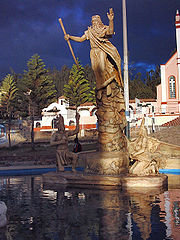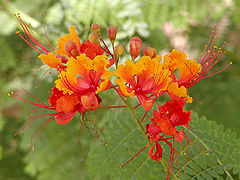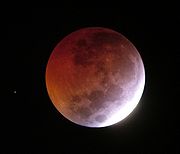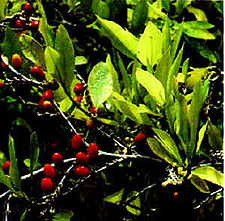
Muisca mythology
Encyclopedia

Pre-Columbian
The pre-Columbian era incorporates all period subdivisions in the history and prehistory of the Americas before the appearance of significant European influences on the American continents, spanning the time of the original settlement in the Upper Paleolithic period to European colonization during...
beliefs of the Muisca
Muisca
Muisca was the Chibcha-speaking tribe that formed the Muisca Confederation of the central highlands of present-day Colombia. They were encountered by the Spanish Empire in 1537, at the time of the conquest...
culture about the origin and organization of the universe.
Creation of the universe
Bague (“the Grandmother”) is a non-material principle of creation, the will, the thought and the imagination of all the things to come. She is a similar concept to the principle of taoTao
Dao or Tao is a Chinese word meaning 'way', 'path', 'route', or sometimes more loosely, 'doctrine' or 'principle'...
in the Chinese mythology.
The time of unquyquie nxie (the first thought) is the time of the cosmic origin, when the thoughts of Bague became actions. This is the time when Bague created the Builders of the Universe and ordered them to create.
The Builders
.jpg)

Bachué
Bachué
The goddess Bachué , is a mother goddess that according with the muisca colombian mythology is the mother of mankind. She emerged of the waters in the Lake Iguaque with a baby in her arms, who grew to become her husband and populate the earth...
(The one with naked breasts): The mother goddess
Mother goddess
Mother goddess is a term used to refer to a goddess who represents motherhood, fertility, creation or embodies the bounty of the Earth. When equated with the Earth or the natural world such goddesses are sometimes referred to as Mother Earth or as the Earth Mother.Many different goddesses have...
, who raised from the underworld to give birth to the human race.
Cuza (The one who is like the night): The male principle of creation. Chibchachum (the one who holds the earth). The universal legislator.
Bochica (the father of civilization)
Nemcatacoa and the Chiminigagua trinity
Trinity
The Christian doctrine of the Trinity defines God as three divine persons : the Father, the Son , and the Holy Spirit. The three persons are distinct yet coexist in unity, and are co-equal, co-eternal and consubstantial . Put another way, the three persons of the Trinity are of one being...
deity, constituted by Chí, Chímini and Chiminigagua.
The gods danced a very long dance (Sas quyhynuca), with the music of the Fo drum, in the first ceremony. This ceremony gave origin to the space
Space
Space is the boundless, three-dimensional extent in which objects and events occur and have relative position and direction. Physical space is often conceived in three linear dimensions, although modern physicists usually consider it, with time, to be part of a boundless four-dimensional continuum...
and time
Time
Time is a part of the measuring system used to sequence events, to compare the durations of events and the intervals between them, and to quantify rates of change such as the motions of objects....
.
Then, the gods created the first materials of the universe: Fiva (the air), Faova (the cosmic cloud) and Ie (the smoke). Then, they created the six directions of the material dimension
Dimension
In physics and mathematics, the dimension of a space or object is informally defined as the minimum number of coordinates needed to specify any point within it. Thus a line has a dimension of one because only one coordinate is needed to specify a point on it...
, and in the middle of the emptiness, they created the center of power Tomsa (bellybutton of the universe). But, still the universe had no consistence, and they waited many bxogonoas eon
Eon
-Science:* Aeon, a very long time* Eon , a collective problem solving project* Eon Mountain, in Canada* A measure of time in the geologic time scale- Fiction :* Eon , by Greg Bear...
s until the sas bequia, the beginning of the world.
The beginning of the world
The World starts with Chimi (“the pulp”), the first material object in the world. Then, in the inners of Tomsa, were incubated the embryos of Stars, embryos of land and embryos of stone. When Tomsa was full, the seeds of the earth emerged and the remains were thrown away, forming the Milky WayMilky Way
The Milky Way is the galaxy that contains the Solar System. This name derives from its appearance as a dim un-resolved "milky" glowing band arching across the night sky...
.
The elements were distributed to the deities. The heat to Sua – the sun
Sun
The Sun is the star at the center of the Solar System. It is almost perfectly spherical and consists of hot plasma interwoven with magnetic fields...
-, the cold to Chía – the moon-, and the clouds and smoke to the earth, but all the things were still seeds and nothing was germinated. Then, Mnya, the gold
Gold
Gold is a chemical element with the symbol Au and an atomic number of 79. Gold is a dense, soft, shiny, malleable and ductile metal. Pure gold has a bright yellow color and luster traditionally considered attractive, which it maintains without oxidizing in air or water. Chemically, gold is a...
, the energy, was united with Chimi, the pulp, and became Chímini, the creative force, which caused the germination of the seeds of all things.
The Great flood
Due to transgressions against the divine laws, Chibchachum brought forth a flood that covered the world and nearly destroyed the human race. Then, the protective god BochicaBochica
Bochica is a figure in the mythology of the Muisca culture, which existed during the arrival of the Spanish conquistadores in areas comprising parts of present day Colombia and Panama...
drove away the waters through the Tequendama Falls
Tequendama Falls
The Tequendama Falls is a 132m high waterfall on the Bogotá River, located about 30 km southwest of Bogotá in the municipality of San Antonio del Tequendama...
, and taught humans the basis of civilization, agriculture, religion, the arts, and crafts. When he was about to leave to his heavenly kingdom, the rainbow
Rainbow
A rainbow is an optical and meteorological phenomenon that causes a spectrum of light to appear in the sky when the Sun shines on to droplets of moisture in the Earth's atmosphere. It takes the form of a multicoloured arc...
appeared and Bochica announced his second coming, far away in the future, in an event marked by death and disease. These events are similar to the biblical histories of Genesis and Apocalypse
Apocalypse
An Apocalypse is a disclosure of something hidden from the majority of mankind in an era dominated by falsehood and misconception, i.e. the veil to be lifted. The Apocalypse of John is the Book of Revelation, the last book of the New Testament...
.
.
The gods and sacred places






- Aba: The maizeMaizeMaize known in many English-speaking countries as corn or mielie/mealie, is a grain domesticated by indigenous peoples in Mesoamerica in prehistoric times. The leafy stalk produces ears which contain seeds called kernels. Though technically a grain, maize kernels are used in cooking as a vegetable...
- BachuéBachuéThe goddess Bachué , is a mother goddess that according with the muisca colombian mythology is the mother of mankind. She emerged of the waters in the Lake Iguaque with a baby in her arms, who grew to become her husband and populate the earth...
: The mother of mankind - Bague: Great grandmother, the mind of the universe
- Biza: The snailSnailSnail is a common name applied to most of the members of the molluscan class Gastropoda that have coiled shells in the adult stage. When the word is used in its most general sense, it includes sea snails, land snails and freshwater snails. The word snail without any qualifier is however more often...
- Bochica: The savior
- Bxogonoa: The period of a generation
- Cona: The mochila bag
- Cuza: The one that is like the night
- Chia: The moon
- Chibchachum: The World Holder.
- Chíe: The urtica plant
- Chiguacá: The verdolaga plant Portulaca oleracea
- Chiinegüi: The small captain fish
- Chimi: The pulp, the first being
- Chímini: The golden Light.
- Chiminigagua: The golden pulp, the force of creation
- Chuhuia: The mouseMouseA mouse is a small mammal belonging to the order of rodents. The best known mouse species is the common house mouse . It is also a popular pet. In some places, certain kinds of field mice are also common. This rodent is eaten by large birds such as hawks and eagles...
- Chyquy: The priests of the calendarCalendarA calendar is a system of organizing days for social, religious, commercial, or administrative purposes. This is done by giving names to periods of time, typically days, weeks, months, and years. The name given to each day is known as a date. Periods in a calendar are usually, though not...
- Cuza fiba, Chuchaviva: The Rainbow (chuquy) deity. The sign of death.
- Fanzaquia: The harvestHarvestHarvest is the process of gathering mature crops from the fields. Reaping is the cutting of grain or pulse for harvest, typically using a scythe, sickle, or reaper...
. - Faoba: The cloud
- Fagua: The star, the morning starVenusVenus is the second planet from the Sun, orbiting it every 224.7 Earth days. The planet is named after Venus, the Roman goddess of love and beauty. After the Moon, it is the brightest natural object in the night sky, reaching an apparent magnitude of −4.6, bright enough to cast shadows...
- Fiva: The air
- Fo: The spirit of music
- Fupqua: The crabCrabTrue crabs are decapod crustaceans of the infraorder Brachyura, which typically have a very short projecting "tail" , or where the reduced abdomen is entirely hidden under the thorax...
- Gacha: The chichaChichaFor the musical genre, see Peruvian cumbiaChicha is a term used in some regions of Latin America for several varieties of fermented and non-fermented beverages, rather often to those derived from maize and similar non-alcoholic beverages...
pot - Gata: The fireFireFire is the rapid oxidation of a material in the chemical process of combustion, releasing heat, light, and various reaction products. Slower oxidative processes like rusting or digestion are not included by this definition....
- Guaquy: The mastuerzo plant Lepidium sativum
- Guayacán: The guayacan tree CaesalpiniaCaesalpiniaCaesalpinia is a genus of flowering plants in the legume family, Fabaceae. Membership within the genus is controversial, with different publications including anywhere from 70 to 165 species, depending largely on the inclusion or exclusion of species alternately listed under genera such as...
spp. - Guamuyhyca: The black captain fish
- Guayque: The chief
- Guecha, Güecha: The warrior
- Gue mny muy: The house of the sacred gold ornaments
- Hayo: The cocaCocaCoca, Erythroxylum coca, is a plant in the family Erythroxylaceae, native to western South America. The plant plays a significant role in many traditional Andean cultures...
plant - Ie: The path; the smoke
- Iomza: The potatoPotatoThe potato is a starchy, tuberous crop from the perennial Solanum tuberosum of the Solanaceae family . The word potato may refer to the plant itself as well as the edible tuber. In the region of the Andes, there are some other closely related cultivated potato species...
- Iosua: The tadpoleTadpoleA tadpole or polliwog is the wholly aquatic larval stage in the life cycle of an amphibian, particularly that of a frog or toad.- Appellation :...
- Itugue: The emptiness
- Mnya: The goldGoldGold is a chemical element with the symbol Au and an atomic number of 79. Gold is a dense, soft, shiny, malleable and ductile metal. Pure gold has a bright yellow color and luster traditionally considered attractive, which it maintains without oxidizing in air or water. Chemically, gold is a...
, the energy - Mocoba: The frailejón plant
- Mohanes: The priests of water
- Muyquyta, Muequetá: The sacred land. (The Bacata savannahSavannahSavannah or savanna is a type of grassland.It can also mean:-People:* Savannah King, a Canadian freestyle swimmer* Savannah Outen, a singer who gained popularity on You Tube...
, placement of the modern city of BogotáBogotáBogotá, Distrito Capital , from 1991 to 2000 called Santa Fé de Bogotá, is the capital, and largest city, of Colombia. It is also designated by the national constitution as the capital of the department of Cundinamarca, even though the city of Bogotá now comprises an independent Capital district...
.) - Nemcatacoa: The protector of the loomLoomA loom is a device used to weave cloth. The basic purpose of any loom is to hold the warp threads under tension to facilitate the interweaving of the weft threads...
- Opaguegue: House of the moon
- Hosca: The tobaccoTobaccoTobacco is an agricultural product processed from the leaves of plants in the genus Nicotiana. It can be consumed, used as a pesticide and, in the form of nicotine tartrate, used in some medicines...
plant - PoporoPoporoPoporo is a device used by indigenous cultures in present and pre-Columbian South America for storage of small amounts of lime . It is constituted by two pieces: the receptacle, and the lid which includes a pin that is used to carry the lime to the mouth while chewing coca leaves...
: Important device in the ceremony of Hayo (cocaCocaCoca, Erythroxylum coca, is a plant in the family Erythroxylaceae, native to western South America. The plant plays a significant role in many traditional Andean cultures...
chewing). - Quemes: The MessengerAngelAngels are mythical beings often depicted as messengers of God in the Hebrew and Christian Bibles along with the Quran. The English word angel is derived from the Greek ἄγγελος, a translation of in the Hebrew Bible ; a similar term, ملائكة , is used in the Qur'an...
s - Quincha: The hummingbirdHummingbirdHummingbirds are birds that comprise the family Trochilidae. They are among the smallest of birds, most species measuring in the 7.5–13 cm range. Indeed, the smallest extant bird species is a hummingbird, the 5-cm Bee Hummingbird. They can hover in mid-air by rapidly flapping their wings...
- Quizo: The perdixPerdixPerdix is a genus of partridges with representatives in most of temperate Europe and Asia. One member of the genus, the Grey Partridge, has been introduced to the United States and Canada....
bird - Saga: The ceremonial fast
- Sie: The water
- Simte: The owlOwlOwls are a group of birds that belong to the order Strigiformes, constituting 200 bird of prey species. Most are solitary and nocturnal, with some exceptions . Owls hunt mostly small mammals, insects, and other birds, although a few species specialize in hunting fish...
- Sua: The sun
- Sue: The parrotParrotParrots, also known as psittacines , are birds of the roughly 372 species in 86 genera that make up the order Psittaciformes, found in most tropical and subtropical regions. The order is subdivided into three families: the Psittacidae , the Cacatuidae and the Strigopidae...
, husband of Bachué, which is sometimes depicted as a child in her arms. - Suhuzy mny: The house of the war ornaments
- Sumguy: The tortola bird Zenaida auriculata
- Sumne: The duckDuckDuck is the common name for a large number of species in the Anatidae family of birds, which also includes swans and geese. The ducks are divided among several subfamilies in the Anatidae family; they do not represent a monophyletic group but a form taxon, since swans and geese are not considered...
- Suquysca: The cerraja plant SonchusSonchusSonchus is a genus of flowering plants in the daisy family Asteraceae. Most of the species are annual herbs, a few are perennial, and some are even woody...
spp. - Tegua: The healer
- Timaná: The ceremonial cup
- Titua: House of feathers
- Tymanzo: The vultureVultureVulture is the name given to two groups of convergently evolved scavenging birds, the New World Vultures including the well-known Californian and Andean Condors, and the Old World Vultures including the birds which are seen scavenging on carcasses of dead animals on African plains...
- Tyba: The owner of the knowledge.
- Tyhyquy: The borrachero plant Datura stramoniumDatura stramoniumDatura stramonium, known by the common names Jimson weed, devil's trumpet, devil's weed, thorn apple, tolguacha, Jamestown weed, stinkweed, locoweed, datura, pricklyburr, devil's cucumber, Hell's Bells, moonflower and, in South Africa, malpitte and mad seeds, is a common weed in the...
- Uaia, Guaia: The mother, the lady
- Ubzaque, Uzaque: Great chiefs
- Yopo: The plant gate of the knowledge
External links
- Mitología Indígena Colombian government page about indigenous mythology.

